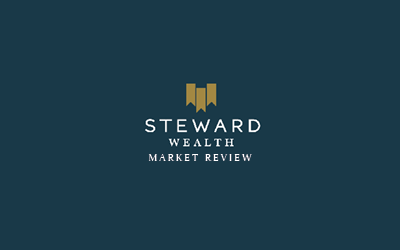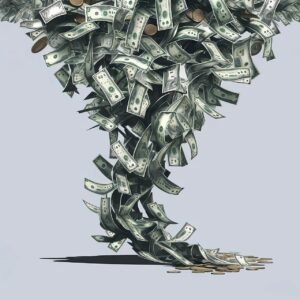Monthly Roundup

Just when you think it’s the time of year that markets might go into a gentle end of year glide path, it turned out December was a pretty eventful month. Domestically we had a negative GDP surprise and the rubbery accounting that passes for the Mid Year Economic and Fiscal Outlook, and internationally we saw the US stock markets hitting new all-time highs despite the Federal Reserve raising interest rates and the European Central Bank modifying its extraordinary monetary policy program.
The “narrative fallacy”
It seems quite remarkable if you cast your mind back to the beginning of 2016 when global equity markets (including Australia and the US) experienced their worst start to a year ever – see the chart below.
S&P500: first 28 days of every year

Source: Factset
Yet we finished the year with slightly around average returns, and indeed once again the three main US stock indices, the S&P500, the Dow Jones and the NASDAQ, each hit all-time highs during December (see the chart below).
The US’s S&P500 and Dow Jones indices are at all-time highs

Source: IRESS
In the midst of last January’s market correction the media was full of breathless quotes from commentators with gems like “as January goes so does the year” and one UK bank filled the headlines when it started the year off by advising its clients to sell everything!
Market commentators will always look for a narrative, and simple human nature usually sees them latch on to the most obvious story at the time. So 12 months ago the story went that markets were doing badly because of the fear of US rate rises plus China’s economic growth was going to screech to a halt, then Federal Reserve Governor Yellen said they were in no rush to raise rates and China reopened the growth spigots and bang, the markets went up. More recently markets are apparently doing well because Donald Trump is expected to usher in a new period of fiscally inspired growth. These narratives are convenient and at best are probably half right, and this ‘narrative fallacy’ is much easier to see in hindsight.
So how can it be that when the Fed put through a well telegraphed rate rise in December 2015 the US markets nosedived and had their worst start to a year ever, whereas a similarly well telegraphed rate rise in December 2016 saw markets rally? If we start by accepting that markets will tend to move higher when growth indicators are better than expected and fall when they’re worse, then we can get some better insight from the chart below. The green line is an index of US economic data surprises – when the surprises are positive the line moves above zero and vice versa. The blue lines track money moving in and out of US equities, again, equities being sold are below the line and vice versa.

Source: Factset
In 2014 the green line spent most of the time above zero, there were more blue lines above the line than below, and the S&P500 went up by 11.4% that year. In 2015, it was the other way around, there were a lot of negative economic surprises that saw $175bn of outflows from US equities and the index probably did well to only fall by 0.7%. Now notice the surprise index turned sharply from being negative to positive in February to end the worst ever start to the year by the S&P500, and lo and behold, we saw the biggest positive surprise in years in November of this year which attracted the fastest pace of inflows on record. It seems more plausible that that is the better explanation for the indices hitting simultaneous record highs than the election of Mr Trump.
Central banks – back in the game
Everyone knew it was coming. We’d all been certain for ages, and sure enough, the Governor of the US federal Reserve, Janet Yellen, didn’t disappoint. She raised the US cash rate from almost nothing to a little bit more than almost nothing – well, in fact it was from 0.5% to 0.75%. It was only the second rate rise in a decade and came almost a year to the day after the last one.
Why did she do that? Despite what President-elect Trump would have you believe, the four charts below show the US economy is steaming along. The first is the US unemployment rate over the past 60+ years (see the chart below); clearly at 4.6% US unemployment is getting to be as low as it’s going to go.

Source: US Bureau of Labor Statistics
This is backed up by the next chart (see below) showing US businesses are finding it harder to fill job vacancies than at any time over the past 20 years – harder even than in 2006 when the economy was overheating.

Source: US Bureau of Labor Statistics
At the same time, inflation has edged back up toward the 2% target zone (see the chart below).

Source: US Bureau of Labor Statistics
And with wages on the rise (see the chart below), it’s unlikely inflation is going to weaken off any time soon.

Source: US Bureau of Labor Statistics
So given the data is at multi-year, if not multi-decade highs, it’s probably fair enough that interest rates should come up just a little bit. But why aren’t they back at levels they were when unemployment and inflation were previously at these kinds of levels (see the chart below)?

Source: US Bureau of Labor Statistics
The simple answer is the demand for borrowing money is much, much lower. After all, interest rates are simply the price of money, and if demand for something goes down, normally so does the price.
What’s of real interest and significance to the market is the Federal Reserve committee’s commentary after the rate rise, where they said US economic growth is strengthening at a “moderate pace and near-term risks to the economic outlook appear roughly balanced”. They forecast three more rate hikes next year, but then again, they had forecast four for 2016.
Meanwhile the European Central Bank (ECB) announced in December that it is going to increase the overall amount it spends on QE by €540bn, which is equivalent to 5% of the EU’s GDP and instead of finishing in March 2017 it will continue until the end of the year. However, it also announced it will reduce the amount of bonds it purchases from €80bn per month to €60bn, which was enough to cause a selloff of European bonds.
By the time the program is finished the ECB will have expanded its balance sheet by €2.3tn. Perhaps it’s working: EU inflation is at its highest in 2½ years at a mighty 0.6% p.a. The thing we’ll never know is what would things have been like without it?
A minor setback?
Australia only needs two more quarters of positive economic growth to equal the longest ever run without a recession of 103 quarters set by the Netherlands. That really is a pretty remarkable record and shows there can be benefits to being the world’s quarry.
However, there was a blip last quarter with the GDP data showing the Australian economy shrank by 0.5% in the September quarter – see the chart below.

What happened? In the previous few quarters public spending at the state and local level made a large contribution to growth but dropped by more than 10% in this one, and unlike during the commodities boom there was no business spending to fill the gap.
So should we be worried? Interestingly the markets barely reacted to the news, which was largely because Australia’s Terms of Trade, the ratio of our export prices to import prices, have shot up recently with the higher iron ore and coal prices, and where our Terms of Trade go, so too does our GDP – see the chart below.
Australia’s nominal GDP growth and the Terms of Trade

Source: Deutsche Bank, ABS
So in the short term, it looks like Australia might equal the Netherlands’ record run of growth, but for the medium to longer term outlook, we urgently need a source of growth to take over from mining and residential construction. Just what that’s going to be is very unclear.
MYEFO: lies, damned lies and accounting rules
Government budgets are as much about delivering a particular political message as providing a snapshot of the economy’s outlook, so perhaps we shouldn’t be too surprised when the government’s Mid Year Economic and Fiscal Outlook (MYEFO) turns out to be questionable.
The government budget is now projected to be in surplus by a wafer-thin $1.1bn by FY2021, but this is after juggling both the revenue and expenditure estimates by a combined total of more than $50bn over four years. And the reason there’s a surplus is not because of any changes in underlying earnings but rather because of a reclassification of about $4bn in earnings from the Future Fund that year.
It’s been pointed out that an ASX-listed company would never get away with such a material accounting change, especially one that was announced by way of a footnote to a graph. To make matters more questionable, the Future Fund’s earnings growth has been increased from its historic average of 7.6% p.a. to 11.7% over the next four years – a whopping 54% higher.
Another issue is the budget assumes tax revenues will benefit from mean reversion and return to the pre-GFC levels we saw during the Howard government. The problem is those tax levels were the product of a once in a lifetime commodities prices boom, favourable demographics and strong population growth; now all three of those factors are working in the opposite direction. Whilst the recent spike in iron ore and coal prices should help, an ageing population is something that doesn’t turn around quickly.
You could mount a pretty strong argument that a lack of political authenticity is helping to drive the cynicism that has seen the political world shift on its axis and in what could be seen as a wake up call for Australia’s political class, a recent Australian National University survey shows 40 per cent of people are not satisfied with democracy, its lowest level since the Whitlam crisis of the 1970s.





